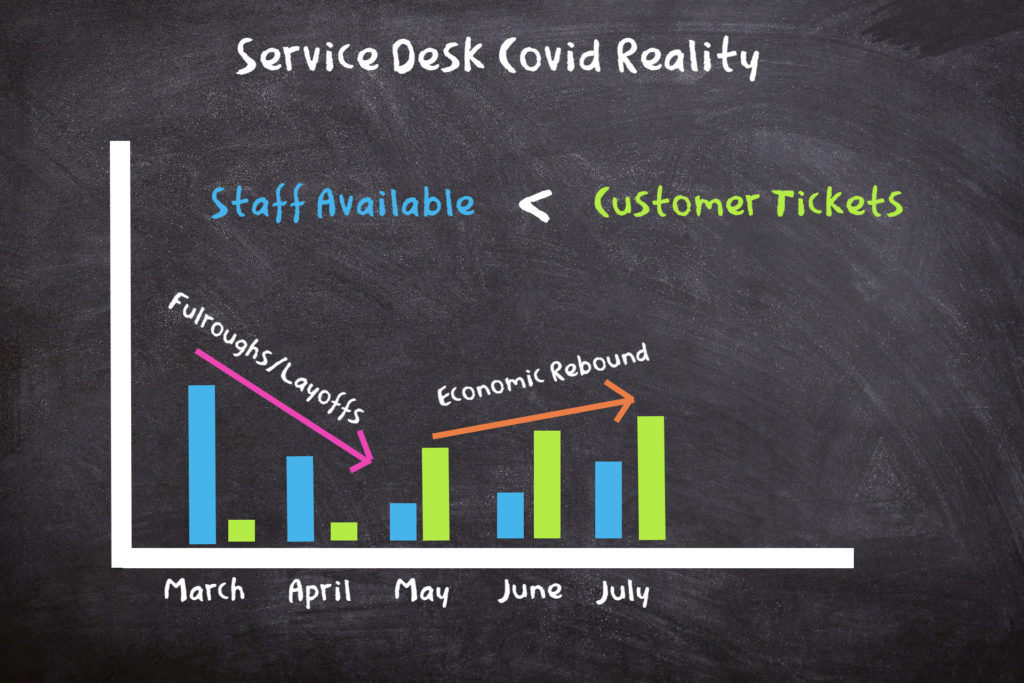The Effects of the COVID-19 Pandemic on Service Desks: Expectations vs. Reality

4 min read
How will the COVID-19 pandemic affect service operations? When COVID-19 spread around the world and became a pandemic in March of 2020, everyone was scrambling for an answer to this question. Service Desks were no exception. At CKM, we’ve worked with a multitude of service desks and similar types of operations over the years, and, while we’d like to think we know a thing or two about the industry, even we had no idea how something so unprecedented was going to affect our customers. It was only when we were able to look at the data that we saw what was going on and could help our customers react appropriately.
In order to flesh out this exercise in humility, I had to reassess my expectations for performance against this new reality. I asked my colleagues to do the same. What surprised me most was not how wrong or how right we each were but how varied our expectations had been. Here we were, a team of people with expertise in a field, and each of us had wildly different expectations of what was going to happen. The consensus: only a real-time view of the data on the ground could help us and our customers make the right decisions in the midst of a dynamic situation.

Our Assumptions and Expectations
Personally, when COVID-19 hit and people started working from home, I imagined this would mostly impact our customers on the demand side. I suspected that we would see a large increase in incoming calls and emails mostly about how to set things up while working from home (adjusting to new work environments, using VPNs, accessing files from a different location, not being able to ask a colleague in the next cubicle questions). On the delivery side, I expected that we would see declining customer satisfaction metrics: more time to resolve tickets, longer queue times and higher abandonment rates. All of this would be due in part to an increase in demand but also because agents themselves were working from home and had to get used to their new environment.
A colleague of mine working with a retail client expected total chaos in supermarkets and that chaos could lead to more issues for customers and employees, resulting in more work for the service desk agents.
In contrast, yet another set of colleagues expected incoming volumes to go down (the exact opposite of what I thought!), especially for retail clients, due to quarantine measures as more people avoided brick and mortar retail stores. This would lead Service Desks to reduce their capacity in order to adjust to the new reality by furloughing and/or laying off agents.

What Actually Happened
For an offshore helpdesk that services a retail customer, we saw demand go down by every possible metric. There were fewer calls into the desk, fewer emails, and fewer tickets as a result. This was likely due to furloughs and to a general slowdown in the economy. At the same time, on the helpdesk side, we saw employee turnover go up as some desks furloughed agents or forced them to take vacation days, leading to lower staffing levels. As a result, projects were delayed, badly needed changes didn’t happen, and maintenance was put off, often indefinitely.
After that initial lull, calls and emails started to flood back in, as the economy sputtered back to life with a whole host of new considerations and new types of issues. Employees returning from furlough or from working at home needed to reset their passwords or get up to date with system changes that had happened in their absence. Demand was going up.
However, capacity was still low, and hiring and training new agents is costly and time-consuming, and training needs to be adapted to a work-from-home configuration. As a result, many desks were left under capacity, and service quality metrics suffered, leading to service-level breaches.
To complicate things even further, the pattern described above is far from the only one we observed. For example, for one desk, we saw calls coming in later in the day, deviating significantly from multi-year patterns of an early morning rush in calls. No one expected that the clients would be working later in the day.
For another desk, we saw queue times increase and abandonment rates decrease, suggesting that the callers may have been growing more patient with the service desk and getting used to longer wait times (perhaps from all the hours-long calls to airline companies to cancel tickets and get refunds or from trying to delay payment of some obligations such as mortgages).
Access to tools that derive actionable insights from real-time data wouldn’t have altered the fast-changing facts but would have allowed desk managers to see changes earlier and take proactive measures as opposed to reacting only when service-level agreements were being breached, leading to high penalties.
Real-Time Data Is the Answer
Some historically based assumptions remained correct for certain industries while others were flat out wrong. But that is not what matters. What matters is the very specific situation you are in at the moment! The only way to accurately get a clear view of the current challenges is to have the most up-to-date data and top-of-the-line tools to make sense of it. Thankfully, we had access to this information through our proprietary tools which allowed our team and our clients to be able to see not only what had happened, but also what was happening, in real-time.
Any theory we could have put together at the outset of the pandemic and the subsequent workforce shifts would have been wrong and oversimplified. It is almost impossible to think through the various systems and all their interactions during such a crisis by relying on assumptions alone.
This is why relying on hard data and tools that can derive insights about the health of the various processes in play, end-to-end, from multiple points of view, and in real-time is invaluable at any time and indispensable in 2020. Real life is simply too uncertain to rely only on old methods and expert opinions. The answer, more than ever, is in knowledge derived from data.
